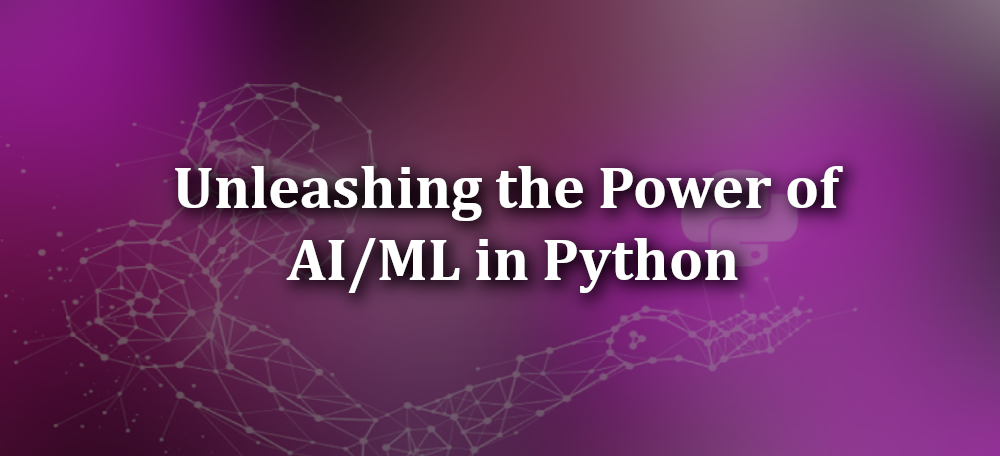Introduction
Artificial Intelligence (AI) and Machine Learning (ML) have emerged as transformative technologies, revolutionizing various industries and reshaping the way we live and work. This blog post explores the significance of AI/ML, focusing on their implementation using the versatile programming language Python. We’ll delve into the fundamentals, applications, and provide practical examples of AI/ML in Python.
Understanding AI and ML
AI refers to the development of computer systems that can perform tasks that typically require human intelligence. ML is a subset of AI that enables systems to learn and improve from experience without being explicitly programmed. ML algorithms analyze data, identify patterns, and make data-driven predictions.
Importance of AI/ML
- Automation and Efficiency: AI/ML algorithms automate repetitive tasks, reducing human effort and increasing efficiency. From data processing to complex decision-making, AI/ML streamlines operations across industries.
- Enhanced Decision-Making: AI/ML systems can analyze vast amounts of data, enabling data-driven decision-making. By uncovering patterns and insights, businesses can make more informed and strategic choices.
- Personalized Experiences: AI/ML enables personalized recommendations, whether in e-commerce, entertainment, or content delivery. By understanding user preferences, AI/ML systems enhance user experiences and engagement.
- Predictive Analytics: AI/ML algorithms can predict future outcomes based on historical data, facilitating proactive planning and risk mitigation. From financial forecasting to healthcare diagnostics, predictive analytics has far-reaching implications.
- Improved Efficiency and Safety: AI/ML technologies optimize processes, detect anomalies, and enhance safety in critical domains like transportation, healthcare, and cybersecurity.
AI/ML Implementation in Python
Python has become the go-to language for AI/ML implementation due to its simplicity, extensive libraries, and strong community support. Here are key components and examples of AI/ML in Python:
Data Preprocessing
Before training ML models, data preprocessing is essential. Python libraries like NumPy and Pandas offer powerful tools for data cleaning, transformation, and feature engineering. For example, Pandas can handle missing data, while NumPy provides efficient numerical operations.
Machine Learning Libraries
Python offers several ML libraries that simplify model development and deployment. Scikit-learn, a popular ML library, provides various algorithms for classification, regression, clustering, and more. For instance, using Scikit-learn, you can implement a decision tree classifier for sentiment analysis.
Deep Learning Frameworks
Python frameworks such as TensorFlow and PyTorch are widely used for deep learning. TensorFlow allows building and training neural networks for image recognition, natural language processing (NLP), and other complex tasks. PyTorch offers flexibility and efficient GPU acceleration.
Natural Language Processing (NLP)
Python’s NLTK (Natural Language Toolkit) library supports NLP tasks like tokenization, stemming, and part-of-speech tagging. With NLTK, you can build sentiment analysis models, text classification algorithms, and chatbots.
Computer Vision
OpenCV, a computer vision library in Python, enables image and video analysis. It provides functionalities for image processing, object detection, and facial recognition. OpenCV facilitates building applications such as autonomous vehicles, surveillance systems, and augmented reality.
Reinforcement Learning
Python’s library, OpenAI Gym, offers an environment for reinforcement learning experiments. Reinforcement learning algorithms learn through interactions with an environment to maximize rewards. You can build AI agents that learn to play games or control robotic systems using OpenAI Gym.
Practical Examples
- Predictive Analytics: Implementing a regression model in Python using Scikit-learn to predict housing prices based on historical data.
- Image Classification: Building a deep learning model in Python using TensorFlow to classify images of different objects or animals.
- Sentiment Analysis: Developing a text classification model using NLTK in Python to determine sentiment (positive, negative, neutral) from customer reviews.
- Chatbot Development: Creating a conversational AI chatbot using Python and NLP libraries like NLTK or spaCy.
Conclusion
AI/ML powered by Python is driving innovation across industries, enabling automation, data-driven decision-making, and personalized experiences. Python’s simplicity, vast libraries, and strong community support make it an ideal language for AI/ML implementation. With practical examples, we have explored the significance and diverse applications of AI/ML in Python. Embracing these technologies opens a world of possibilities, propelling businesses and society towards a more intelligent and efficient future.
